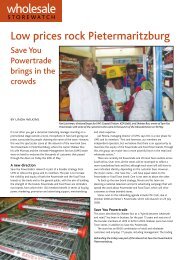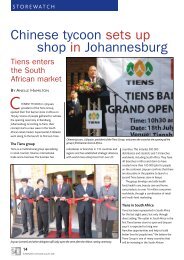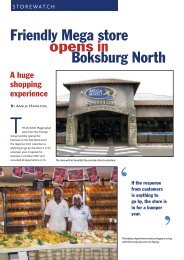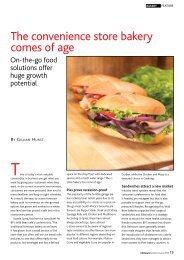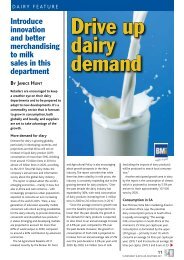The South African solution to supply chain - Supermarket.co.za
The South African solution to supply chain - Supermarket.co.za
The South African solution to supply chain - Supermarket.co.za
Create successful ePaper yourself
Turn your PDF publications into a flip-book with our unique Google optimized e-Paper software.
Strikes are a prime<br />
example that<br />
illustrates the need<br />
for <strong>co</strong>ntingency<br />
planning, with the<br />
need <strong>to</strong> get orders<br />
<strong>to</strong> cus<strong>to</strong>mers but<br />
not put any vehicles<br />
or staff at risk<br />
<strong>to</strong> do so<br />
With last year’s truck strike, <strong>co</strong>ntingency<br />
planning had <strong>to</strong> be done daily. “No-one<br />
knew how long it would last so everyday<br />
we had <strong>to</strong> look at which areas were<br />
affected and establish whether it affected<br />
the outbound delivery from the carrier DC<br />
or inbound <strong>to</strong> the s<strong>to</strong>re,” he says.<br />
14<br />
09886-CGSR010MOVINGGOODSEFFICIENTLY19.11<br />
05December201210:09:57AM<br />
SUPERMARKET & RETAILER, APRIL 2013<br />
SUPPLY CHAIN<br />
▲<br />
incurring the least possible <strong>co</strong>sts. Reacting<br />
<strong>to</strong> disasters can get very expensive very<br />
quickly,” says Aling.<br />
Another very real example is when a<br />
public holiday falls on a nominated delivery<br />
day (NDD). It is easy enough <strong>to</strong> shift the<br />
delivery day <strong>to</strong> the next day (say <strong>to</strong> the<br />
Tuesday when a public holiday falls on<br />
the Monday) but the retailer needs <strong>to</strong> be<br />
prepared and able <strong>to</strong> receive additional<br />
s<strong>to</strong>ck on the previous NDD (say, the Friday<br />
before) <strong>to</strong> <strong>co</strong>ver the s<strong>to</strong>ck required for the<br />
extra day after the weekend.<br />
With s<strong>to</strong>res now reducing their backroom<br />
space, it is easy <strong>to</strong> see why a retailer might<br />
be<strong>co</strong>me unstuck, as he literally does not<br />
have the additional capacity <strong>to</strong> hold an<br />
extra day’s s<strong>to</strong>ck. This will also affect the<br />
turnaround time of carriers as the receiving<br />
bay may now be handling Monday’s<br />
deliveries 100 on <strong>to</strong>p of the regular Tuesday’s<br />
trucks. Logtrix’s Jason Kelly suggests that<br />
95<br />
retailers order up on KVI lines the week<br />
before <strong>to</strong> limit the extra deliveries <strong>to</strong> just<br />
75<br />
the perishable items.<br />
Supply <strong>chain</strong>s need <strong>to</strong> be quite adaptable<br />
so they can ac<strong>co</strong>mmodate these changes.<br />
25<br />
“Carriers and retailers need <strong>to</strong> be quite<br />
creative 5 in their planning <strong>to</strong> ensure <strong>supply</strong><br />
in these periods. It’s a trade-off between<br />
s<strong>to</strong>ck<br />
0<br />
holding (how long will it last?) and<br />
the next delivery (when can I realistically<br />
receive more?),” notes Kelly.<br />
Contingency plans need <strong>to</strong> be put in place so<br />
planned or unplanned events don’t ultimately<br />
affect the s<strong>to</strong>ck on shelf.<br />
Aling also mentions strikes as a prime<br />
example that illustrates the need for<br />
<strong>co</strong>ntingency planning. “Our transporter’s<br />
rule during the strike was that they would<br />
do whatever they <strong>co</strong>uld <strong>to</strong> get orders <strong>to</strong><br />
cus<strong>to</strong>mers but would not put any vehicles<br />
or staff at risk <strong>to</strong> do so.”<br />
Last year’s snow that closed the N3 for<br />
two days is another unexpected event that<br />
had <strong>to</strong> be worked around. “We run a crossdock<br />
facility in Durban because we have<br />
a good highway linking Johannesburg and<br />
Durban but, all of a sudden, we didn’t have<br />
that anymore and it meant that we had<br />
problems <strong>supply</strong>ing cus<strong>to</strong>mers in Durban.<br />
We had <strong>to</strong> get our vehicles going round the<br />
N3 <strong>to</strong> reach Durban, which adds <strong>to</strong> lead<br />
times etc.,” says Aling.<br />
At s<strong>to</strong>re level<br />
<strong>The</strong>re’s an easy way <strong>to</strong> see if retailers are<br />
getting <strong>supply</strong> <strong>chain</strong> right … ”have they got<br />
s<strong>to</strong>ck on shelf?” asks Kelly. That being said,<br />
out-of-s<strong>to</strong>cks (OOS) aren’t necessarily just<br />
the retailer’s responsibility. Supply <strong>chain</strong><br />
management is about the retailer, their<br />
suppliers and the person who carries all the<br />
goods. “It needs <strong>to</strong> be all three getting it<br />
right,” he says.




